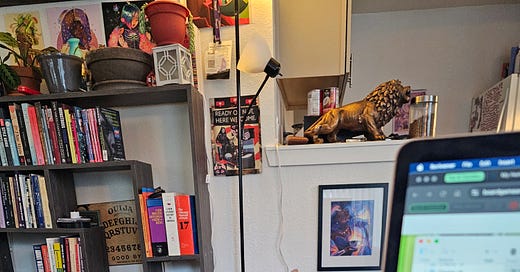Through the Eyes of Evil: Choice of POV in Toni Morrison’s Bluest Eye
A look at how Morrison used POV in her novel The Bluest Eye.
Writing Skins is a reader supported author newsletter that shares excerpts from an award nominated speculative fiction writer’s craft journals. It offers a vulnerable, funny, and interesting look at the writing life, craft, and storytelling.
Craft Chat is the writing craft section of the newsletter where subscribers and me go through a subject, piece of media, or technique together.
Morrison is not a thoughtless writer. She isn’t careless. She makes choices in the moment while writing that builds on an idea or theme, but usually a theory on writing or people she has. And while many times later in interviews she might not remember the scene or moment, but she knows why it was important to do it that way.
Sometimes these choices are hard to understand but powerful on the page. As a writer of darker work and sometimes dark moments, I always take notice when an author as skilled as Morrison is at rendering tenderness chooses to put on the skin of a terrible person in a terrible time like in Beloved where the first reenactment or portrayal of Sethe killing her baby and trying to kill her children is shown through the eyes of racist whites and slave catchers.
In the Bluest Ey it appears in an even worse way by depicting a child rape scene viscerally from the POV of the rapist. The scene, which I won’t reproduce or quote in any way in this essay, is only two pages and a couple hundred words. Told in a very direct style. The words used are mainly of the physical world and memory sense.
It is a disturbing and sickening scene that is made worse by the reflective and responsive scenes that frame it. It reminded me of another scene in The Heaven & Earth Grocery Store by James McBride that also depicted a child rape. In The Heaven & Earth Grocery Store, the terrible scene is placed between two scenes one of shame and self-blame and one of tender friendship, making the scene not only awful but heartbreaking in a way the scene in the Bluest Eye isn’t because of how Morrison frames the scene and her intentions behind the book as a whole.
In the Bluest Eye the scene is in-between a scene where the rapist considers his daughter. It is not sexual but filled with rage, remembrance, and confusion. The scene following the rape is all about the child searching for a man to give her blue eyes. This makes the rape scene sad in a different way. The heartbreak is there, but not as severe as in The Heaven & Earth Grocery Store because we are not in the child’s point of view when she goes looking for blue eyes. Morrison choose not to do this because she didn’t want to make the reader affected by the pain that the child faces through the story.
In the foreword of Bluest Eye, Morrison writes about her intentions behind the novel and how she wanted to get to the bottom of a feeling that a friend of hers had of wanting to have blue eyes and how Morrison believed that this stemmed from a deep hatred of herself that society placed on her:
“I focused, therefore, on how something as grotesque as the demonization of an entire race could take root inside the most delicate member of society: a child; the most vulnerable member: a female. In trying to dramatize the devastation that even casual racial contempt can cause, I chose a unique situation, not a representative one…In exploring the social and domestic aggression that could cause a child to literally fall apart, I mounted a series of rejections, some routine, some exceptional, some monstrous, all the while trying hard to avoid complicity in the demonization process Pecola was subjected to. That is, I did not want to dehumanize the characters who trashed Pecola and contributed to her collapse. One problem was centering the weight of the novel’s inquiry on so delicate and vulnerable a character could smash her and lead readers into the comfort of pitying her rather than into an interrogation of themselves for the smashing.”
I think this intention to keep the abusers in Pecola’s life human so that the reader couldn’t distance themselves from the abusers in the pain that Pecola felt is the same intention Morrison had when she choose to get into the POV of the slave catchers in Beloved. She didn’t want the reader to think how awful of them but how awful of us.
Have you read The Bluest Eye? If so, what are your thoughts?



